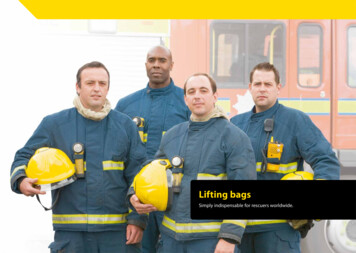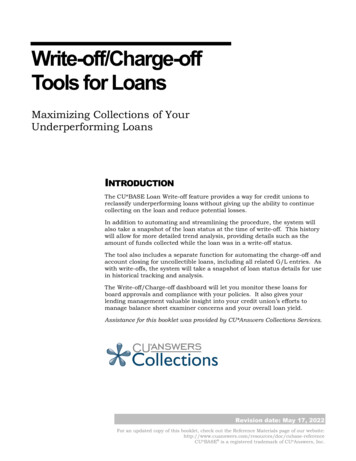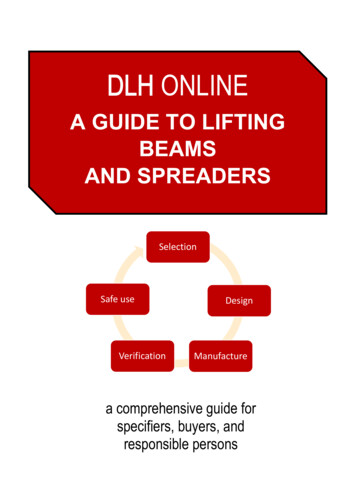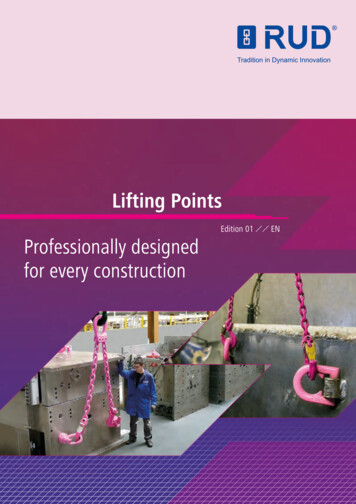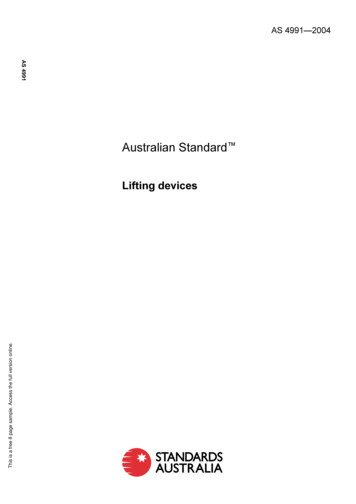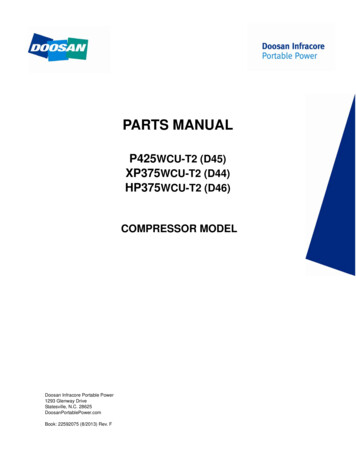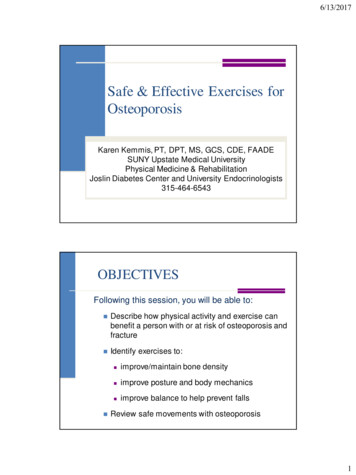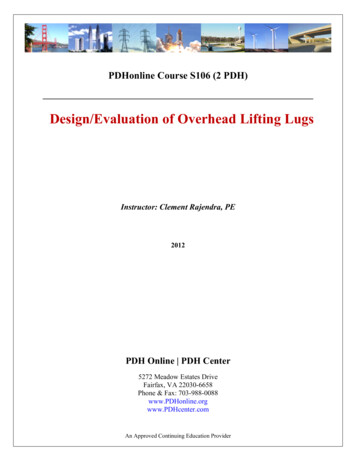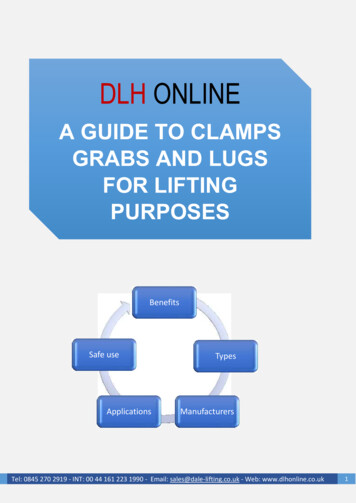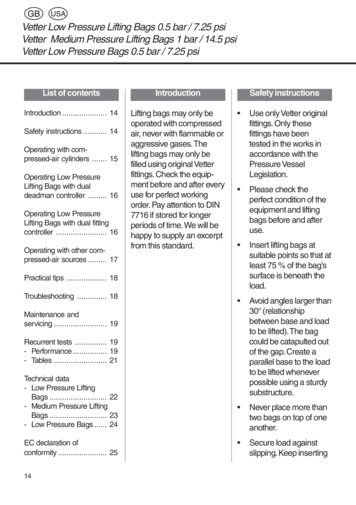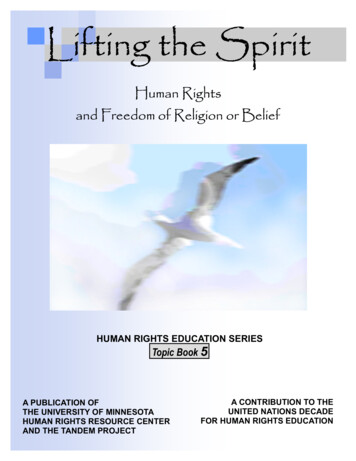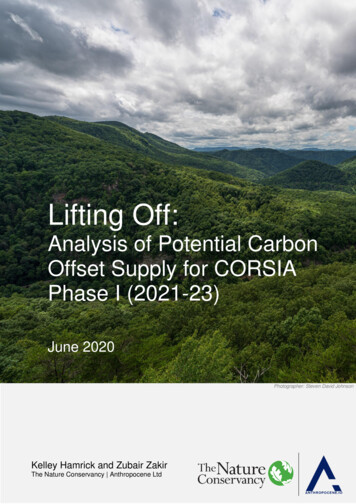
Transcription
Lifting Off:Analysis of Potential CarbonOffset Supply for CORSIAPhase I (2021-23)June 2020Photographer: Steven David JohnsonKelley Hamrick and Zubair ZakirThe Nature Conservancy Anthropocene Ltd
Letter from the AuthorsSince we began this analysis in December 2019, mandatory travel bans and lockdownsdesigned to tackle the spread of the COVID-19 virus brought international air travel to agrinding halt. The aviation industry group IATA estimates that 4.5 million flights have beencancelled and airlines will lose an estimated 314 billion in revenue. While these eventscontinue to unfold, we would like to share some thoughts on what these events mean for theoriginal objectives of this paper.Last year, uncertainty surrounding the Carbon Offsetting and Reduction Scheme forInternational Aviation (CORSIA) could be distilled into two main questions: whether progresswould be made in the Article 6 negotiations at COP25 in Madrid, and which programs theInternational Civil Aviation Organization (ICAO) Council would approve as Emissions UnitPrograms in 2020. While the ICAO Council approved the list of Eligible Unit Programs for thefirst pilot phase in March 2020, a number of new questions have been raised about futuresupply and demand in CORSIA. These include: Calls for renegotiation of airline baseline calculations: The airline association IATAhas recently pushed for countries to postpone CORSIA emission reporting deadlinesfor airlines, and to switch the baseline calculation from a 2019-2020 average to a 2019only baseline. This intervention may or may not be addressed by the next scheduledICAO Council meeting in June. [April 8, 2020] Extensions of deadlines for airlines to report 2019 emissions data: Eight countrieshave announced an intention to extend the May 31st deadline for their airlines. Ability of airlines to report emissions and participate in CORSIA: Both Aviancaand LATAM, two Latin American airlines, recently filed for chapter 11 bankruptcy. Morecarriers may follow as a result of COVID-19. [May 11 and May 26, 2020] Additional requirements for airlines to meet environmental targets, madeconditional by government aid: The French government has made AirFrance-KLMbailout money conditional on select climate change measures and the Austriangovernment is requiring a more stringent emissions reductions target for AustrianAirlines. These and other countries may use their COVID-19 response measures asan opportunity to strengthen both the financial and environmental sustainability ofairlines. [updated as of June 11, 2020] Uncertainty about finalizing post-2020 trading of offsets within CORSIA: TheUnited Kingdom government announced its intention to postpone this year’s UnitedNations Framework Convention on Climate Change 26th Conference of the Parties(UNFCCC COP26) until November 2021, when the Article 6 negotiations (and relatedrules for double counting within CORSIA) will hopefully be finalized. [May 29, 2020]While the underlying assumptions for demand used in this analysis remain in flux, we stronglybelieve that these findings bear relevance for decisions which may be made in the comingmonths. Additional research will be needed to further understand the impact of COVID-19 onthe aviation sector and CORSIA in the coming months and years.We will be following these decisions with interest, and with the hopes of being able to sharelessons learned here with the broader carbon market community.Kelley Hamrick and Zubair Zakir1
Key FindingsWe evaluated the following five programs using publicly available data: The CleanDevelopment Mechanism (CDM), Verra’s Verified Carbon Standard (VCS), the Gold Standard(GS), the Climate Action Reserve (CAR) and the American Carbon Registry (ACR). The ChinaCertified Emission Reduction (CCER) program was not included in this analysis, due to a lackof publicly available data.1Using parameters from the recent ICAO Council decision on CORSIA Eligible EmissionsUnits, we estimate between 17–24 million tCO2e (Mt) of CORSIA-eligible credits from thefive programs evaluated in this analysis are immediately available for sale; an additionalpotential supply between 111–158 Mt from 2016-2020 could be produced; and a projectedsupply of 122–174 Mt that stem from existing and registered pipeline projects in 2021-2023.An additional 0–341 Mt could be produced from natural climate solutions (NCS) activitiesbetween 2016-2023, contingent on approval from the ICAO Council and strong demandsignals. Findings include: CORSIA demand cover: Based on pre-COVID demand estimates from ICAO2, thissupply would provide between 91%-131% of required volumes over the same time period.COVID estimates range widely; see section 2 for additional details. Supply shortfall risk: We anticipate a risk of undersupply of credits for use withinCORSIA during the 2021-2023 period, if the potential supply of credits is not realizedunder the current list of eligible programs. These estimates may change if ICAO acceptsadditional programs later this year. Natural Climate Solutions (NCS): The role of existing NCS activities at this pointappears limited in the initial crediting period to 2020. Given strong policy and marketsignals, NCS credits could contribute from 0-341.3 Mt (see section 3 for insights into theassumptions that result in this wide range of potential supply). Data access, standardization and transparency: Programs can and should providebetter public data for ongoing evaluation, as data are currently difficult to access.Existing Potential2016-2020 2016-2020Figure 1 CORSIA supply estimates by program and time period evaluated with a 2016 crediting startHighLowHighLow-20.0 Mt40.0 Mt60.0 Mt80.0 Mt100.0 MtExisting 2016-2020120.0 Mt140.0 Mt160.0 MtPotential 2016-2020CDMLow2.4 MtHigh3.4 MtLow93.3 MtHigh133.2 MtVCS9.8 Mt14.0 Mt14.0 Mt20.1 MtGS4.0 Mt5.8 Mt2.8 Mt4.0 MtCAR0.1 Mt0.1 Mt0.0 Mt0.0 MtACR0.8 Mt1.2 Mt0.5 Mt0.7 MtTotal17.1 Mt24.5 Mt110.6 Mt158.0 MtAnalysis is based on public data found here: CDM, Verra, GS, CAR, and ACR (Note: Our analysis used data from Verra’sproject database. This was migrated to Verra’s new project registry in April 2020.) While some CCER issuance information canbe found in individual project reports, the only database of CCER projects was last updated in 2017 and does not haveinformation needed to determine eligible CORSIA projects.2ICAO CAEP Analysis on the estimation of CO2 emissions reductions and costs expected to result from CORSIA12
Literature ReviewWe conducted a literature review before embarking on our own analysis. Most reportedestimates of potential credit supply are out of date and do not include the latest eligibilityrestrictions. See Appendix for more details.Findings include: Few estimates share pertinent details about volumes by program or specifics ofmethodological choices, which can significantly influence calculations. Few estimates consider alternative demand sources (outside of CORSIA) and theeffect on supply. Estimates of potential supply have fallen drastically over the past five years; yetolder, out-of-date estimates remain regularly cited.Figure 2 Literature review of CORSIA supply volume estimates, ranging for the pilot phase (20212023) across the entire CORSIA program (2021-2037)80007000Estimated credit supply ear of PublicationNo restriction 2035No restriction 203532013- 2035201920202021
1. The majority of eligible 2016-20 credits are not yetissued, presenting a high degree of uncertainty inavailable supply.Based on our analysis we estimate that existing supply of net3 credits (verified minus retiredand/or canceled credits) range between 17–24 Mt. The same projects which have yet to verifyvolumes for this period have an estimated potential supply between 111–158 Mt. Additionally,there is a projected supply of 121–174 Mt that could be produced between 2021 to 2023, ifthe ICAO Council extends the eligible vintage dates past 2020.4 An additional 0–341 Mt couldbe produced from NCS activities between 2016-2023, depending on decisions made by theICAO Council and by demand signals from CORSIA and other carbon credit buyers. Additionalassumptions were made in these NCS-specific calculations: see page 5 for more information.Figure 3 CORSIA "high" supply estimates by program and time period evaluatedwith a 2016 crediting startSupply EstimatesProjected 2021-2023 volumePotential 2016-2020 volumeDemandEstimateExisting 2016-2020 volumeICAO Demand Est. 2021-2023(Pre-COVID)-20.00 40.00 60.00 80.00 100.00 120.00 140.00 160.00 180.00 200.00Metric Tonnes of CO2e (Millions)CDMVCSGSACRCARDemandKey assumptions used include (see Appendix I for more information): For the “low” estimates, we assumed 30%5 of all existing, projected, and potentialvolumes would not be available for sale to account for (i) time-delay lag between anover-the-counter (OTC) transaction and tracked retirement on a registry; and (ii) potentialunder-delivery from initial project estimates. Program-specific constraints include assuming 100% of California-eligible credits inthe Climate Action Reserve (CAR) and American Carbon Registry (ACR) plan to transferto the California program and will not be available to meet CORSIA demand.6 Further constraints identified, but not accounted for here, include variables such asnon-quantified program pipelines, program specific rule-changes, host-country use indomestic programs (such as in Colombia, South Korea, South Africa, and China) and othersources of competing use, in particular from future demand from voluntary buyers.3Net supply estimated for all standards except CDM, for which this information was not available.Potential supply is estimated from unverified supply between 2016-2020. Projected supply is estimated from anticipatedverifications in 2021-2023 from both existing projects and from projects currently in the pipeline.5The 30% discount rate was chosen based on the authors’ experience within the market; however, it is not based on anyformal review or study. Should research become available, we would welcome the chance to update our analysis with suchdata.6Additional research is needed here. While this assumption is based on historical conversion of California-eligible credits fromACR and CAR, the California program will be limiting the use of carbon credits to 4% this year as opposed to 8% in the past.This may weaken demand from California compliance buyers.44
2. Supply shortfall risk within CORSIA’s first voluntaryphase.The first phase (2021-2023) of CORSIA is a voluntary phase, one which, as of April 3rd 2020,83 countries have signed on to and represent 76.6% coverage.7 Here, we summarize a rangeof demand estimates, including that of ICAO, the Environmental Defense Fund (EDF)8, andour own estimates.9However, it is important to note that COVID-19 has thrown these estimates into doubt.Pre-COVID estimates assumed that aviation emissions would increase throughout the firstphase; now, analysts are considering various scenarios where flights return to pre-COVIDlevels or whether demand for flights will remain suppressed in the years following 2020. Figure4 shows the latest analysis by EDF,10 which modeled five scenarios for future flight emissionsbased on a 20%, 50% and 70% decline in 2020 airline emissions based maintaining the 20192020 baseline. If airlines were to use a 2019-only baseline, EDF calculates no credit demandin Scenarios 2-4, a range of 26-72 Mt (Scenario 1), and 37-105 Mt (Scenario 5).The airline industry group IATA has proposed dropping 2020 from the baseline calculations,and relying only on 2019 emissions data. The group worries that be keeping the 2019-2020baselines, the precipitously low emissions this year will create an even bigger burden forairlines to comply under CORSIA in a time when airlines are already hurting financially. Othergroups have advocated for a wait-and-see approach, arguing it is better to wait and see howdemand for future air travel is impacted before making a decision. These groups recommendkeeping the rules as they stand until a more informed decision can be made at the next ICAOCouncil meeting in 2023, while relying on flexibility11 rules already embedded into the programto address immediate CORSIA compliance concerns.EDF’s 2019-2020COVID Estimates, withFlexibility MechanismScenario 1Pre-COVIDCORSIADemandEstimatesFigure 4 CORSIA Demand and Supply Estimates in 2021-2023Internal est.*Scenario 2Scenario 3Scenario 4Scenario 5EDFICAO (2019) est.020406080100120140160180200High (20% decline in 2020 emissions)Extreme (70% decline in 2020 emissions)Severe (50% decline in 2020 emissions)Pre-COVID* Demand estimate calculated by author (Zubair Zakir), are based on pre-Covid19 projected growth in international flights up to 5.7% per n/CORSIA/Pages/state-pairs.aspxEDF – ICAO’s market-based measure – interactive tool9These estimates are based on the assumption that near-term supply of sustainable aviation fuels (SAF) and use of SAFremains low. If there is a shift in the SAF market, that could further lower demand for credits under CORSIA.10EDF authors indicated to us that Scenarios 2 and 3 are the most likely.11EDF – CORSIA and Covid-1985
3. Natural Climate Solutions (NCS) credits could beramped up to meet anticipated shortfallThe role of existing NCS activities at this point appears limited in the initial creditingperiod to 2020 but could address an anticipated supply shortage, if clear demandsignals are given for jurisdictional REDD . Such signals could be provided through the fullapproval of the FCPF, Verra’s Jurisdictional and Nested REDD (JNR), the Architecture forREDD Transactions’ (ART) The REDD Environmental Excellence Standard (TREES), andthe BioCarbon Fund’s Initiative for Sustainable Forest Landscapes (ISFL) in subsequent ICAOCouncil decisions.NCS in the Climate Action Reserve and American Carbon RegistryOur analysis included one key assumption about the role of demand in the American CarbonRegistry and Climate Action Reserve programs: that 100% of California-eligible credits willcomplete this transition instead of responding to CORSIA demand.12 Based on ourcalculations, 100% of ACR projects eligible for California have transitioned, while an additional38.8 Mt in CAR (of which 33.1 Mt is NCS) could transition to the California market.It is possible that some California-eligible credits are sold to CORSIA buyers; Table 1calculates the volume of credits that are eligible for both CORSIA and California’s ETS. Whereand whether credits are sold to each of these programs, or to the voluntary markets, willdepend on competition for US credits by these various buyers. Further studies of demandestimates for domestic US voluntary action and for the California ETS would be worthwhile, inorder to gain a deeper understanding of how these alternative demand sources might impactsupply for CORSIA.Table 1: Projected NCS supply for CORSIA, if sales shift from California’s Emission Trading Scheme to CORSIACAR – all creditsCAR – NCS only creditsACR – all creditsACR – NCS only creditsPotential supply for 2016-202046.4 Mt39.8 Mt93.9 Mt85.5 MtProjected supply for 2021-202328.2 Mt25.6 Mt59.3 Mt56.0 MtNCS in Verra’s VCS and JNR StandardsBased on the Technical Advisory Body’s recommendations, ICAO approved a handful of NCSmethodologies as eligible under Verra’s VCS Standard in March 2020. These specific projectbased methodologies are: VM0012, VM0022, VM0026, VM0033, VM0036, and VM0040.Based on our analysis, none of these methodologies have projects that began a creditingperiod after 2016. Therefore, our analysis predicts that there will not be any eligible supplyfrom these approved NCS methodologies for the first pilot phase of CORSIA.13This could change if the ICAO Council approves additional VCS methodologies. When Verrarecently submitted additional documentation for its conditionally eligible JNR Standard, it alsoincluded a proposal for its already-approved VCS standard. The proposal would allow for moreNCS project-based methodologies, which Verra argues do not need to be nested because theactivities present a low risk of leakage. This could change the immediately available supply ofNCS credits.1412This assumption is based on historical conversion of California-eligible credits from ACR and CAR. However, the Californiaprogram will be limiting the use of carbon credits to 4% this year as opposed to 8% in the past and has introduced a newrestriction for buyers to purchase 50% of offsets from projects with a “direct environmental benefit” in the state. These newregulations may change the future rate of conversion.13This is based on our analysis of existing and pipeline projects. However, now that ICAO has clearly defined whichmethodologies are allowed, there could be new projects that appear in the pipeline in 2020 onwards. Additional analysis in thefuture could examine whether the ICAO decision has spurred new NCS projects within Verra.14More research is needed to understand how much supply would be available here.6
All other NCS projects will need to transition to Verra’s conditionally eligible Jurisdictionaland Nested REDD Standard; furthermore, only those projects that are able to successfullyintegrate into either JNR’s Scenario 2 or 3 restrictions will be eligible. This means that standalone projects using a jurisdictional baseline will not be recognized (Scenario 1). Instead, allprojects will need to be fully integrated (“nested”) within Scenarios 2 and 3. At the moment, noJNR programs exist across Scenarios 1 – 3. It is possible, however, that projects could migrateto Scenario 1, which Verra notes “may be the first phase of jurisdictional programdevelopment.”If projects were to transition into Scenario 2 or 3, it is possible that a number of NCS creditscould be eligible for the pilot phase of CORSIA. Currently, there are: an estimated 89.8 Mt credits in Verra’s pipeline that could be active from 2021 –2023,15 an estimated 1.2 Mt credits available from NCS projects with a 2016 start date, an estimated 25.2 Mt credits available from NCS projects with a 2013 start date, and an estimated 111.3 Mt credits available from NCS projects with a 2010 start date.Why are we including earlier start dates? It is likely that project developers will need torecalculate their baselines and other project elements when transitioning to Verra’s JNRStandard. If these changes are significant, it is possible Verra might recognize those projectsas newly started. That said, projects transitioning from a trendline to a jurisdictional historicalbaseline will likely face significant cuts to their original baselines. Here, in order to beconservative, we estimate that projects would have to reduce their emissions by half.16Based on these calculations, it is possible that NCS projects could transition into eitherScenario 2 or 3 and represent 113.7Mt, but this relies on the speed at which jurisdictions –many of which may not have considered REDD before – can implement the JNR Standard.NCS in the Forest Carbon Partnership FacilityIn March 2020, the ICAO Council recognized the World Bank’s Forest Carbon PartnershipFacility’s (FCPF) Carbon Fund as conditionally eligible. The Carbon Fund serves as both afund and a standard for jurisdictional REDD : the Fund developed its MethodologicalFramework back in 2013 to provide guidance to tropical forest countries seeking to receivepayments for REDD emissions reductions. Currently, 11 contributors have committed 902.7M in this fund for the 19 recipient countries working on REDD emissions reductions.In reality, though, only a fraction of these emissions reductions might be eligible for CORSIA.That’s because there are two traches within the Carbon Fund: Tranche A and Tranche B.Contributors to Tranche A will receive transferrable emissions reductions, while donors toTranche B will be paying for results but will not receive any credits. Currently, the majority ofcontributors have made investments into Tranche B by using Overseas Development Aid. Of 902.7M committed to the Carbon Fund, only 5.2% has been committed to Tranche A.Assuming that all recipient countries agree to sell emissions reductions at 5/tCO2e – whichhas been the case for the four countries (Democratic Republic of Congo, Chile, Ghana, andMozambique) that have so far signed Emissions Reductions Purchase Agreements – thismeans that an estimated 8.7 Mt will be available for sale through Tranche A, with call optionsthat could result in a slightly higher volume. This is out of an estimated 186.5 Mt that couldbe produced by recipient countries by 2025.17We identified 30 NCS projects in Verra’s pipeline, but it is possible that these projects have been abandoned. These projectscomprise nearly all of Verra’s pipeline of projects – non-NCS projects would produce an estimated additional 5.5 Mt.16A 50% reduction is used in an effort to be conservative; more research is needed to determine what an average cut is forprojects transitioning to a nested REDD carbon-fund-dashboard157
Table 2: List of Tranche A Contributors18Tranche A ContributorsTotal FundingAustraliaBP Technology VenturesThe Nature ConservancyUnited States 18.4M 5.0M 5.0M 18.5M% of Total Funding(linked to % of ERs received)2.0%0.6%0.6%2.0%Clearly, Tranche A might not provide an initial substantial volume. However, this underscoresthe need and opportunity for future FCPF emission reductions in CORSIA. Most countrieshave included only a single jurisdiction of varying sizes in their REDD programs for theCarbon Fund. With additional demand signals, countries could much more easily scaleexisting programs to encompass new jurisdictions, based on the years of work setting upthe technical monitoring and capacity building for REDD programs in-country.NCS in ART/TREES and the Carbon Fund’s ISFLIn ICAO’s second call for applications in April 2020, both ART/TREES and BioCarbon ISFLapplied. Additional analysis is needed to determine the projected and potential 2016-2023volumes from these programs: however, at the very least, ART/TREES will potentially produceup to 12 Mt as noted in the Letter of Intent between Gabon and the Central African ForestInitiative.19 Many other tropical forest countries have spent years finalizing their REDD readiness activities and have capacity to begin monitoring results, so it is also possible thatadditional volumes could be produced. Additional analysis is needed.Total Potential NCS Supply for CORSIAIn conclusion, NCS projects and programs could provide an additional 341.3 Mt not currentlyanticipated by this analysis, if the right guidance and signals are made. However, this is likelyan overestimate of what could realistically be produced, even with strong policy support forNCS and before considering other sources of potential demand for the same units. Shouldfurther sources of NCS-credit supply not be approved for use under CORSIA in the voluntarypilot phase, near-term supply options may need to consider activities with a pre-2020 creditstart date.Table 3: Summary of projected NCS supply volumes that could potentially be available for CORSIAVerraCARACRFCPFExisting supply for2016 – 20200133.1 Mt300Potential supply for2016-2020039.8 Mt485.5 Mt40Projected supply for2021-2023113.7 Mt225.6 Mt56.0 Mt8.7 Mt(more research needed onability to scale)TREES0012 Mt(more research needed onability to scale)(more research needed onability to scale)ISFL00Total0125.3 Mt216.0 MtThis might change if the ICAO Council recognizes additional VCS methodologies, as proposed in Verra’s latest application.2Assuming all Verra NCS projects excluded by the TAB can successfully transition to Scenario 2 or 3 under Verra’s JNRStandard, and in the process earn a new project start date. It is not likely that all projects would be able to complete this transition,and those that did would likely have much lower baselines than before. Thus, we estimate only 50% of the estimated 227.5 Mtvolume might make this transition successfully.3We estimate 100% of this supply will transition into the California market. However, future demand may change and warrantsfurther research.4We also assume earlier in this report that 100% of this supply will transition into the California market. However, there is a betterchance that this supply could be used for CORSIA instead, if demand is system/files/documents/FMT Note CFM-2019-2 FCPF CF Budget nts-for-preserved-rainf.html8
4. Data access and transparency remains an issueAs ICAO did not offer a public comment period around the decision to limit eligible projects tothose beginning a crediting start date in 2016 or later, negotiators often relied on their ownanalyses or external analyses for insights on how such a decision would affect the supply ofcredits. There are several issues with this, including:1. Public estimates of Clean Development Mechanism (CDM) credit supply rangesvary widely: from estimates of 4.3-6.5 GtCO2e by 2030 to 0.1-2.9 GtCO2e, dependingon restrictions and assumptions applied. These various approaches also make itdifficult to compare the analyses side-by-side. Existing literature has broad estimateranges, with analysis that cannot easily be cross compared; assumptions buried intoreport details; and static information which does not reflect the rapidlychanging/evolving landscape of domestic actions. There is a need for reliable andunbiased analysis, where assumptions are clearly delineated and comparable withincurrent and upcoming UNFCCC and ICAO markets discussions.2. Public data from other programs (American Carbon Registry, Climate ActionReserve, Gold Standard, Verra) varies and often does not contain detailsrelevant to the TAB decision. This includes critical information around aproject’s first crediting period. While these programs have this data available uponrequest, it is not public like that of the CDM and presents a transparency issue toresearchers and companies looking to understand the market for CORSIA.3. Finally, we were not able to include any research around existing or potentialsupply of credits from China’s GHG Voluntary Emission Reduction Program,which does not appear to have any public data.9
5. Recommendations:As CORSIA becomes operationalized and airlines look to purchase carbon credits20,there is a need for industry-wide data integrity standardization. While these data areavailable to market participants, stakeholders and policymakers today, it is difficult to accessand to compare. Such alignment would make it easier to predict current and future supply andwould also benefit policymakers across other negotiating forums such as those in Article 6.We recommend proactively engaging both the approved programs (CAR, ACR, GS, VCS,CDM, CCER) and those seeking approval (FCPF, JNR, ART/TREES) to discuss thesefindings, including the limitations of analysis possible with data currently provided and thebenefits available through standardised data reporting. In particular, the fact that CCERissuance data has not been updated since 2017 is concerning.Additional research is needed to better understand competing demand for CORSIAeligible credits. Nearly all of the studies we reviewed prior to this (see Appendix II for moredetails) did not consider the impact than non-aviation buyers would have in the market. Ouranalysis did account for offsets already retired on the voluntary markets or transitioned for usewithin the California ETS; however, additional analysis could be used to better understandfuture demand within the California market. Also, we did not examine data from other currentand upcoming markets, such as those in Korea, Colombia and China. Such data could reducethe amount of available supply of CCER or CDM credits. Furthermore, our analysis did notconsider supply constraints that may arise from countries seeking to keep emissionsreductions for use towards their own Nationally Determined Contributions (NDCs).Competing demand considerations are especially relevant for NCS credits: while ouranalysis of supply and demand revealed that few NCS credits will initially be availableunder CORSIA, this is due to pre-existing demand in other markets. Most Californiaeligible credits under CAR and ACR, for example, come from forestry projects. Though Verradoes not have any existing NCS projects that meet the ICAO Council criteria, 42% of all Verraissued credits come from NCS projects. The volume of NCS-issued credits has been risingfor the last couple of years, with 72% of Verra’s issuances in 2019 coming from NCS projectsas opposed to only 38% in 2016.21 More research is needed to determine if and how quicklyNCS supply can ramp up to meet additional demand from -2020/10
Appendix 1: MethodologyOur analysis focused on four main indications of supply:Verification supply (where possible) or issuance supply, based on a crediting start dateor estimated project start date of 2016 or later and with a 2020 cut-off. Programs (alsocalled standards) do not share the same types of data so we used conservative assumptionswhen making this data comparable: CDM: Crediting start date used. Verra: Verification period of projects used – the first year of the first verification period wasused to find crediting start date. Gold Standard: Monitoring periods (i.e., verification period) of projects used: the first yearof the first verification period was used to find crediting start date. Climate Action Reserve: Single vintage years were provided for issuance batches (noverification or monitoring periods were publicly available). The oldest vintage yearassociated with each project is assum
1 Analysis is based on public data found here: CDM, Verra, GS, CAR, and ACR (Note: Our analysis used data from Verra's . Figure 2 Literature review of CORSIA supply volume estimates, ranging for the pilot phase (2021-2023) across the entire CORSIA program (2021-2037) No restriction - 2035 No restriction - 2035
